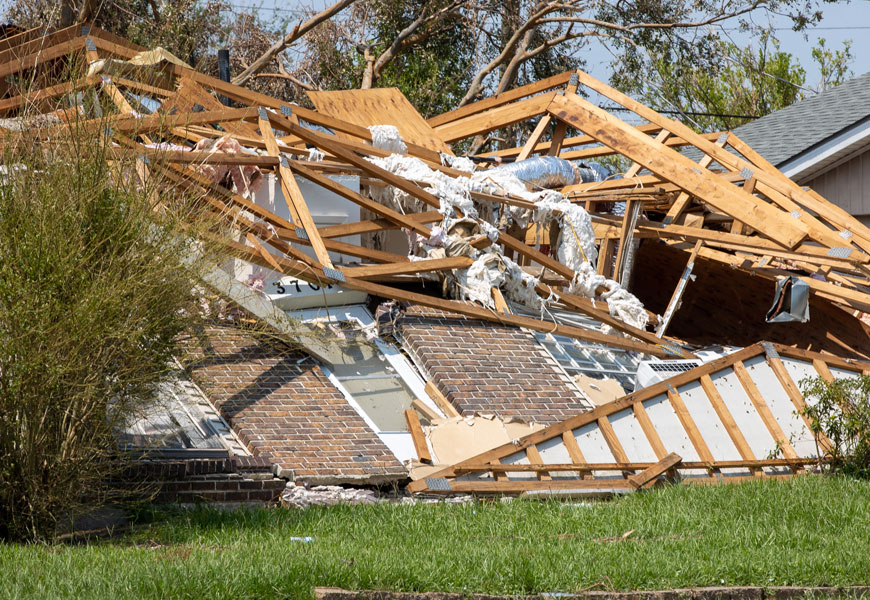Integrity
New dashboard strengthens disaster preparedness
Key takeaways:
- A new interactive dashboard from Allstate and the U.S. Chamber of Commerce helps communities assess weather-related risks and economic consequences.
- Every $1 not spent on disaster resilience today could cost $7 – $33 in future losses.
- Intentional action and smart investments can protect homes, communities and livelihoods.

By Allstate
October 29,2025
Small choices, big payoffs
The difference between a house withstanding a natural disaster – or not – can come down to something as small as the type of nails used to build it.
"With fortified construction, they use a nail that's a little bit longer and has a shank on it," said Nicholas Hebert, an Allstate Agent in Houma, Louisiana. "[It] has double the holding capacity of a regular nail and it costs only a fraction more."
These small details may seem minor, but Hebert knows they play a major role in structurally protecting homes from hurricanes, floods and other extreme weather events.
Disaster preparedness lessons from hurricanes
The son of an agent who also served Louisiana's gulf coast, Hebert has a lifetime's worth of disaster recovery examples that show the benefits of investing in resiliency and preparedness. He's also seen what happens when those investments aren't made.
After Hurricane Katrina, Louisiana spent $14 billion on levees, which held strong during Hurricane Ida, preventing catastrophic flooding.
"It's a big testament to the measures we took as a community to protect ourselves from catastrophes and natural disasters. But it also showed we still have work to do," Hebert said.
When Hurricane Ida struck the Louisiana coast in 2021, it revealed new vulnerabilities.
Older homes without fortified roofs, like Hebert's, suffered significant damage, while homes with resilient construction and roof upgrades were generally intact.
"My own roof was ripped off. I couldn't live there; the interior flooded out," he said.
Interactive dashboard helps reveal community risk and economic impact
New research on community resiliency investments by Allstate, the U.S. Chamber of Commerce and the U.S. Chamber of Commerce Foundation identifies where people are most susceptible to specific weather-related risks.
The report modeled the economic impact of hurricanes, tornadoes, wildfires, droughts and flooding in risk-prone areas.
Every $1 not invested in resilience today can cause between $7 and $33 in lost future economic activity.
To encourage those investments, we've released an interactive resilience dashboard.
This tool offers:
- Specific nationwide disaster risks communities and individuals face.
- Local weather-related risks (like hurricanes, wildfires and floods).
- Actionable steps and tips for homeowners and communities to strengthen resilience.
It brings risk and impact data together with visual summaries. Users can see the economic benefit of different investment levels and how they could affect jobs and GDP after a future severe-weather event.
Prepared, not just lucky
Hebert's experience shows the payoff of acting on these insights. It's why he uses his Ida experience to help customers understand that the right investments – even small ones – make a big difference.
"I'll show my own loss report sometimes. It's a way to say, here's why that roof upgrade is important. Without it, you're replacing your sheetrock, your walls, and you're not living in your house for six months, versus just fixing a few shingles."
Hebert wants to ensure his community can withstand whatever Mother Nature throws at it.
His advocacy is part of a more than 25-year effort by Allstate to encourage communities, businesses and individuals to prioritize climate resiliency. Because preemptive action is one of the best ways we can make insurance affordable and available even as weather becomes more extreme.
"Look closely at those post-disaster photos," Hebert tells his customers. "Everyone notices the blue tarps and piles of rubble but often miss that one house that's still intact. You might think, 'boy, they were lucky to be spared.'"
"Maybe they weren't lucky. Maybe they were just prepared. That's the mindset we all need to adopt."
Protecting communities from catastrophe
Natural disasters can be unavoidable, but being prepared doesn't have to be. Our new dashboard, developed with the U.S. Chamber of Commerce, helps communities identify weather-related risks and make proactive investments for the future.
Check out the dashboard
